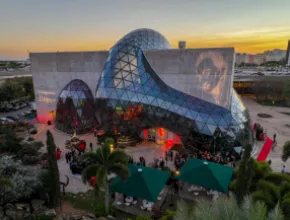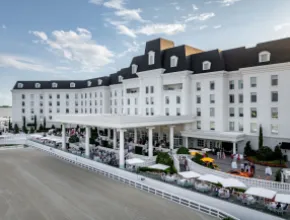Wedged between north and south, the Commonwealth of Pennsylvania, the fourth most-visited state, presents a tempting world outside the meeting room. A rural escape awaits delegates in every region of Pennsylvania, and its countryside locales are prime territory for recreation, relaxation and cultural pursuits.
The Keystone State claims heritage sites from three defining wars—the French and Indian War, the Revolutionary War and the Civil War—and it boasts 200-plus historic covered bridges that can be incorporated into group outings.
With the Appalachian Plateau covering the western half of the state and the same mountain range running through much of the east, Pennsylvania serves up more than 20 ski areas.
From any point, a state park, state forest or state game land is within a 15-minute drive, according to the Pennsylvania Tourism Office, and there is at least one winery within 45 minutes. More than 100 wineries open to the public are scattered across seven wine regions with nine wine trails.
Pennsylvania leads the U.S. in its number of projects under way to convert abandoned railroad beds for recreational use. The 121 projects total 974 miles.
Whether planners wish to plant groups in a secluded retreat complete with a host of outdoor pursuits or send them on a relaxing day trip to quaint rural hamlets, Pennsylvania presents a wealth of opportunities for countryside getaways.
Eastern Pennsylvania
Philadelphia’s historic eye-openers are enough to keep groups captivated, but pre- and post-meeting offerings and customized excursions provide Philly attendees with numerous ways to experience the pastoral East.
“Lancaster is one of the most popular tours, as is Valley Forge,” says Lauren Sheehy, director of project development at GEP Philadelphia, a destination management company. “History buffs could do Valley Forge and Gettysburg—less than two hours away—in one long day. But there is so much to see.”
For groups bent on shopping, Sheehy adds, rural Bucks County to the north is a popular itinerary, and for gardens and art museums, groups often move west and south to Montgomery and Chester counties and the Brandywine Valley.
The Valley Forge CVB, which promotes Montgomery County, is fortunate; the Valley Forge Convention Center, a major suburban convention facility, is close to one of the country’s largest shopping centers and one of the nation’s historic treasures. The center, with 108,000 square feet of exhibit and meeting space and two connected hotels, is 20 minutes from downtown Philly, less than two miles from King of Prussia Mall and less than one mile from the 3,600-acre Valley Forge National Historical Park, site of Gen. George Washington’s winter encampment of 1777-78.
“When business is finished, attendees have the park’s 30 miles of running, biking and hiking trails to let off steam,” says David Bradley, convention sales director for the Valley Forge CVB. “They can rent bikes or take ranger-led bike or trolley tours, and living history interpreters and storytellers bring the encampment to life.”
The area also claims North America’s largest concentration of gardens and arboreta—more than 50—including Longwood Gardens, Morris Arboretum and Chanticleer Garden.
Planners deciding on a museum- or art-themed tour have choices such as the Barnes Foundation, the Wharton Esherick Studio Museum, the Abington Art Center, and the Museum of Art at Ursinus College of Art.
For African-American heritage sites, the Valley Forge CVB has teamed with central region CVBs in Gettysburg, Lancaster and York to promote the Quest for Freedom trail for both groups and individuals.
Bradley also says the region’s great outdoors makes it a natural setting for team building, conferences and training.
“With 17 conference centers, the area hosts the largest concentration of conference centers in the U.S., with six that are IACC-certified,” he says.
One is Normandy Farm Hotel and Conference Center at Blue Bell, featuring a hotel that is less than 2 years old and high-tech meeting space in a transformed historic cattle barn. Among the other options—all IACC-approved—are the ACE Conference Center at Lafayette Hill; the Desmond Hotel and Conference Center in Malvern; the Gregg Conference Center at American College in Bryn Mawr; and the Villanova Conference Center at Villanova University in Radnor.
Known for its small towns and single-lane winding roads, Bucks County, located north of Philadelphia, is positioned as a rural getaway with inns and bed-and-breakfast properties, as well as more than 100 attractions, including seven wineries.
“Bucks County is the place to go for small corporate meetings and retreats,” says David Jackson, CMP, corporate sales manager for the Bucks County CVB. “Board retreats, seminars and workshops are our most popular types of meetings.”
Two standout attractions are the town of New Hope, which fronts the Delaware River and is filled with art galleries and boutiques, and the town of Lahaska’s Peddler’s Village, an historically themed center with 70 stores and restaurants, a dinner theater and a meetings-equipped hotel.
The CVB splits its 608 square miles into three regions: the recreation-rich northern lakes region; the cultural region in the center, with New Hope and museum-packed Doylestown, which includes the James A. Michener Art Museum, the Moravian Pottery and Tile Works and the Mercer Museum; and the heritage region, featuring historic sites and mansions along the Delaware River and the Washington Crossing Historic Park, where the Continental Army crossed the icy river on Christmas night in 1776.
With the cities of Allentown, Bethlehem and Easton, the Pocono foothills furnish the state’s third-largest metro area: Lehigh Valley, 60 miles northwest of Philadelphia.
“Groups can meet downtown and within 10 or 15 minutes be in the countryside for activities or team building,” says Tracey Werner, public relations director at the Lehigh Valley CVB. “We’re home to the Lehigh Valley Wine Trail, with nine family-owned wineries, two ski resorts and several highly rated golf courses.”
“A bike and boat program puts meeting-goers on our local rivers and side roads for a day of fun,” she says, and other group options range from white-water rafting to sporting clays.
One getaway destination, the four-season Bear Creek Mountain Resort, located 12 miles from Allentown, plans to open a hotel and finish a meeting space expansion this fall.
Another 60 miles to the northwest is Luzerne County and Wilkes-Barre, as well as the nearby Scranton, home to coal-mining heritage attractions and the IACC-certified conference facility at the Hilton Scranton. Like Lehigh Valley, the region markets the year-round recreation of its mountains and lakes.
These population centers flank the Pocono Mountains—2,400 square miles of wooded peaks, lakes and valleys, a four-season, four-county outdoor destination. There are no metro areas here, just small townships, 35 golf courses, more than a dozen meetings properties, and 140-plus ski slopes and trails.
Undergoing a building boom, the long-established playground is reviving and upgrading, giving groups additional options for countryside retreats.
The $92 million Great Wolf Lodge—the area’s first new resort in 30 years—opened in Scotrun in October 2005. Mount Airy Lodge in Paradise Township, which dates to the 1930s, closed five years ago, and the $412 million, 200-room Mount Airy Resort and Casino will debut on the site this fall with meeting space and a 2,500-slot casino.
Closed for 30 years, the historic Hotel Fauchere in Milford reopened last summer after a five-year restoration. The hotel has 16 guest rooms and adjacent group space.
The Lodge at Woodloch, a $30 million spa retreat with 60 guest rooms, opened in Hawley last June.
Additionally, Pocmont Resort and Conference Center at Bushkill is planning a $3.5 million, 10,000-square-foot spa.
Among the other developments, Stroudsmoor County Inn in Stroudsburg is slated to open a new event facility for 300 people this fall, and in 2005, Skytop Lodge opened a $6 million conference center.
Central Pennsylvania
The central region’s rolling farmland embraces the state capital of Harrisburg, Hershey, the Pennsylvania Dutch countryside of Lancaster and York, and Gettysburg National Military Park.
Hershey Harrisburg Regional Visitors Bureau (formerly the Hershey–Capital Region CVB) promotes the area as the “Heart of PA,” a two-county destination that includes the capital and Hershey, just 14 miles from downtown.
“The Sweetest Place on Earth” celebrates its 100th birthday this year. Since 1907, when Milton Hershey opened Hershey Park with a merry-go-round, an amphitheatre and 5-cent Hershey bars, Hershey has morphed into a countryside mega destination with hotels, a convention center featuring 100,000 square feet of function space, theme parks and attractions, and sports draws that include the Hershey Bears AHL team. New for 2007 is the Boardwalk at Hershey Park, with five water attractions, including one billed as the “the largest water-play structure in the world.”
From Hershey, Gettysburg is 60 minutes southwest, Lancaster is 40 minutes southeast, and York is 50 minutes south.
When the American Bus Association polled member operators last year on their top non-big-city destination, Lancaster won. The heart of Pennsylvania Dutch Country beat runners-up Branson and Tunica.
“We’re an easy getaway location, yet it takes you to another world,” says Cara O’Donnell, media relations manager at the Pennsylvania Dutch CVB.
The Amish, Mennonite and Brethren farming communities deliver a unique culture rich in arts and crafts and a nostalgic glimpse of a rural past.
“It’s a big part of our heritage, and it is what really sets us apart, but people are amazed at how much there is to do here,” O’Donnell says.
Lancaster has plenty of family attractions, entertainment and dining, more than two dozen museums, farm tours, and a growing arts scene, according to O’Donnell.
“For meeting groups we provide a wonderful blend of high-tech amenities in a metropolitan area with miles and miles of scenic Amish farmland,” she says, adding that outdoor recreation and team building includes everything from maneuvering through an enormous cornfield maze to kayaking down the Susquehanna River.
According to Abby Crooks, destination marketing manager at the York County CVB, the most popular off-site activities for groups in the York area, located just west of Lancaster, are golf, wineries and factory tours, which also give groups a chance to experience the countryside.
Last year, the CVB began promoting the “Uncorked York Wine Trail,” which has 11 wineries.
One tour offered focuses on a great symbol of escape: Harley-Davidson’s largest manufacturing facility.
York also promotes itself as the “Snack Food Capital of the World,” and other tours offered spotlight Martin’s and Utz, both potato chip companies; Revonah Pretzels; Snyder’s of Hanover Pretzels; Wolfgang Candy Company; and D.F Stauffer Biscuit Company.
“We have quaint towns, hiking, biking, skiing, and water sports, and more than 20 golf courses at reasonable rates,” Crooks says. “There are eight county parks and three state parks, and two great dairies to visit.”
To the northwest near the center of Pennsylvania is State College, the quintessential sports-crazy college town with tree-lined streets, coffee houses and art galleries. It is home to the main campus of Penn State University, and the university’s Penn Stater Conference Center Hotel, with 58,000 square feet of IACC-approved meeting space.
The Central Pennsylvania CVB promotes the fact that you can be in the countryside within five minutes—with “breathtaking views of endless mountains and fields.” The region claims some of the country’s best fly fishing, while other options include mountain biking Mount Nittany and touring historic towns such as Boalsburg Village.
South of State College, the community of Altoona is home to the Allegheny Mountains CVB, which promotes the many attractions in and around Blair County.
When President James Buchanan, a Lancaster native, wanted to get away, he would go to Bedford, southwest of Altoona and midway between Harrisburg and Pittsburgh. He spent 40 summers at the Bedford Springs Hotel, his “summer White House.”
Closed since 1986, the property will reopen this summer following a three-year $108 million restoration and expansion. The Benchmark Hospitality-managed Bedford Springs Resort will include 218 rooms, a 30,000-square-foot spa, 20,000 square feet of meeting space, and a renovated Donald Ross-designed golf course.
Karen Moraghan, spokesperson for the resort, explains that historic buildings are being carefully restored to their original splendor.
“Past guests will feel they’ve stepped back in time,” she says.
Moraghan describes Bedford as “a countryside oasis” with over 100 miles of bike trails, activities ranging from river rafting to horseback riding, and two ski resorts within 30 minutes. The resort will have a fleet of bikes available and its own trout fishing.
Planners can incorporate Bedford’s rich history into events. Downtown Bedford is home to the house that President George Washington made his headquarters during the 1794 Whiskey Rebellion, and Bedford County features 14 covered bridges and the Fort Bedford Museum, built on the site of a fort of the French and Indian War.
About 35 miles northeast of Bedford is Lake Raystown Resort and Lodge, set on Pennsylvania’s largest inland lake and offering an array of outdoor recreational pursuits. The property plans to unveil a new meeting and banquet venue overlooking the lake this spring. The facility will feature a ballroom accommodating up to 500 people, meeting rooms, a boardroom, and a reception lobby with a fireplace.
Western Pennsylvania
Pittsburgh’s great outdoors escape is the Laurel Highlands, located 50 miles from the city in the Alleghenies.
The Laurel Highlands region has two major meetings resorts: Seven Springs Mountain Resort in Champion, the state’s largest ski and year-round resort, and Farmington’s Nemacolin Woodlands Resort and Spa, with award-winning golf. Nemacolin includes the 42-room Falling Rock hotel, which offers group space for up to 580 people and received its first AAA Five Diamond award for 2007.
Two signature attractions are located in the area: Frank Lloyd Wright’s Fallingwater and Kentuck Knob homes, which he built in the 1930s. Both homes are open to the public.
Less than 30 miles from Fallingwater and Kentuck Knob, a third Wright-designed home, the circa-1957 Duncan House, will open this summer at the 125-acre Polymath Park in Acme. Brought from its original location in Illinois, it will include meeting space for 125 guests. The Duncan House will be located on a private estate with two other homes designed in the 1960s by Wright apprentice Peter Berndtson. The estate will be available for lodging, functions and corporate retreats.
Patrick Flynn, meetings and conference manager at the Laurel Highlands Visitors Bureau, says the area is rich in retreat-type facilities, such as Antiochian Village, Laurelville Retreat and Meeting Center, and the Bishop Connare Center.
“We offer some of the East’s most outstanding outdoor recreational opportunities,” he says. “We have championship golf along with rock climbing, ropes courses, horseback riding, paintball, and Hummer trails.
“Groups can go rafting on the Youghiogheny River or hike the Great Allegheny Passage, the East’s longest rail trail.”
The 150-mile Great Allegheny Passage, which runs through the Laurel Highlands, is the region’s big outdoors story. Twenty years in the making, it was at press time about to be connected to the 184.5-mile Chesapeake and Ohio Canal National Historical Park in Cumberland, Md. Together they form the spine of the Potomac Heritage National Scenic Trail, stretching from Washington, D.C., almost to Pittsburgh, the country’s longest multipurpose trail, according to the Rails-to-Trails Conservancy. Along its length are bike shops, restaurants, bed-and-breakfast properties, and shuttle services. Grand opening events are scheduled to be held in Washington, D.C., in June.
The Great Allegheny Passage currently runs within 10 miles of Pittsburgh. By year’s end it will connect to the city’s Glenwood Bridge just in time for Pittsburgh’s 250th anniversary celebrations next year.
Pittsburgh’s 36-acre Point State Park, where the Allegheny and Monongahela rivers meet downtown, is undergoing a pre-anniversary facelift. Although closed, its Fort Pitt Museum and historic blockhouse remain open.
The one-time Steel Town has a certified “green” convention center, and its rivers had rejuvenated enough to attract 35,000 people for the 2005 CITGO Bassmaster Classic.
Bob Imperata, executive vice president at the Greater Pittsburgh CVB, says the city has more than 21 miles of river trails, and in less than one hour, visitors can be in the beautiful countryside.
“Golf is big in Butler County, where there are dozens of excellent courses,” he says. “Washington County has the Pennsylvania Trolley Museum, Indiana County is home to the Jimmy Stewart Museum, and people are surprised that a back roads drive into Lawrence County will take them deep into Amish country.”
In the Monroeville Area east of Pittsburgh, Boyce Park offers skiing in the winter and hiking, picnicking and other outdoor options during warmer months.
Monroeville is also home to historic sites dating to the 1800s, including McGinley House, Old Stone Church, Little Stone Bridge, and McCully Log House.
In the northwestern part of the state, Pennsylvania claims 51 miles of Lake Erie coastline.
Erie, the fourth-largest metro area, has sandy beaches, 17 campgrounds and almost as many golf courses. In its front yard is Presque Isle State Park, a 3,200-acre sandy peninsula that arches into Lake Erie and features a 13-mile loop road and more than 15 miles of trails. Activities range from boating, fishing and swimming to hiking and cross-country skiing, and it is reputed to be one of the country’s top birding spots.
In May 2006, the park gained a new attraction: the Tom Ridge Environmental Center, which includes 7,000 square feet of exhibits on the isle and lakes region. It also has a 175-seat large-screen theater, and it can handle events of up to 500 people.
For More Info
Allegheny Mountains CVB 814.943.4183
www.amcvb.com
Bucks County Conference
and Visitors Bureau 215.639.0300
www.experiencebuckscounty.com
Central Pennsylvania CVB 814.231.1400
www.centralpacvb.org
CVB of Greater Monroeville 412.856.7422
www.visitmonroeville.com
Erie Area CVB 814.454.7191
www.visiteriepa.com
Gettysburg CVB 717.334.6274
www.gettysburgcvb.org
Greater Pittsburgh CVB 412.281.7711
www.visitpittsburgh.com
Hershey–Harrisburg Regional Visitors Bureau 717.231.7788
www.hersheyharrisburg.org
Johnstown/Cambria County CVB 814.536.7993
www.visitjohnstownpa.com
Laurel Highlands Visitors Bureau 724.238.5661
www.laurelhighlands.org
Lehigh Valley CVB 610.882.9200
www.lehighvalleypa.org
Luzerne County CVB 570.819.1877
www.tournepa.com
Pennsylvania Dutch CVB 717.299.8901
www.padutchcountry.com
Philadelphia CVB 215.636.3300
www.philadelphiausa.travel
Pocono Mountains CVB 570.421.5791
www.poconomeetings.com
Valley Forge CVB 610.834.1550
www.valleyforge.org
York County CVB 888.858.9675
www.yorkpa.org






